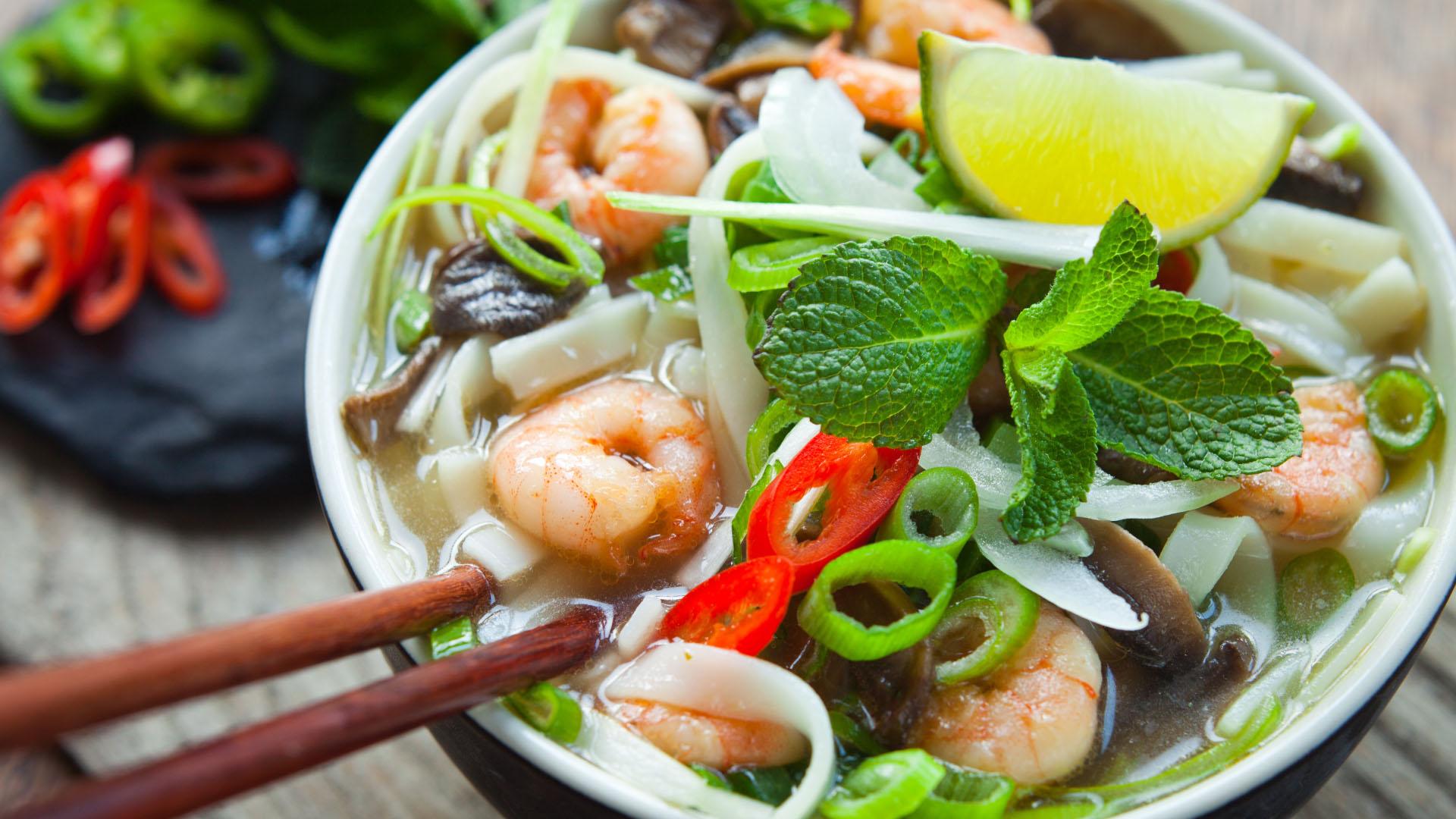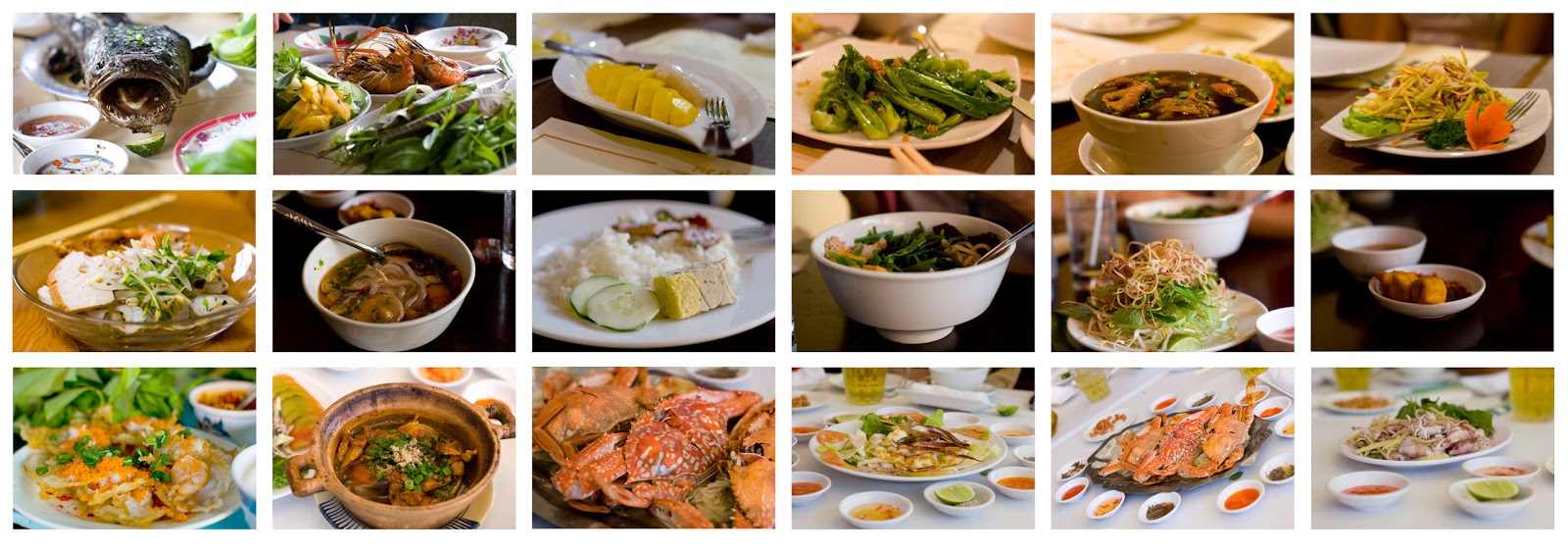
Vietnamese Foods
Vietnamese cuisine is reflective of the Vietnamese lifestyle, from the preparation to how the food is served. Each Vietnamese dish has a distinctive flavor which reflects one or more of these elements. Common ingredients include fish sauce, shrimp paste, soy sauce, rice, fresh herbs, and fruits and vegetables. Vietnamese recipes use lemongrass, ginger, mint, Vietnamese mint, long coriander, Saigon cinnamon, bird’s eye chili, lime, and basil leaves. Traditional Vietnamese cooking is greatly admired for its fresh ingredients, minimal use of oil, and reliance on herbs and vegetables. With the balance between fresh herbs and meats and a selective use of spices to reach a fine taste, Vietnamese food is considered one of the healthiest cuisines worldwide.
Pho
Pho is a prevalent, dish familiar to all Vietnamese people, who eat pho from infancy. It is most commonly eaten in the morning, but there are also people who eat it at noon for lunch or late at night. Pho is a glossy kind of flattened paste prepared from ordinary rice that is cut into strips. Pho bo (beef pho) is prepared from ox-bones or pig-bones. The broth, which is scented with ginger, is poured into a bowl containing already cooked noodles.
Well-done lean beef is cut into thin slices, softened and scented, then put on the surface. Pho ga (chicken pho), is made from pig and chicken bones. Chicken without the bones is cut into slices or fibres and served in the soup. Fresh onion stripped into thin bits, fresh red peppers, black pepper, and lemon are ingredients indispensable to a bowl of pho, which is nourishing and appealing to all.
Bun
Bun, a kind of rice vermicelli, is at the same time both a luxurious and a popular food in Viet Nam. There are many different names for bun, which refer to its shape, such as vermicelli made in tangled threads (bun roi), vermicelli served with pickled fish (bun nam), vermicelli made in a leaf (bun la), and bun dem tram (vermicelli bought in the hundreds).
Rice vermicelli can be eaten with many other dishes, including grilled meat rolls (called bun nem), shellfish (called shellfish soup and rice vermicelli), omelette, lean pork paste, chicken, (called bun thang), sour rice field crab soup (called bun rieu), pig trotter meat, rolled meat paste (called bun moc), and beef and pig trotters (called bun bo gio heo). Every region, every community, and even every restaurant have their own rice vermicelli, differing from one another by composition, preparation, and ingredients.
Banh Cuon
Ordinary rice paddy is soaked in water until it become soft; then it is ground into a very thing paste. This paste is steamed to make round cakes, each a little bigger than the hand and very thin. Each cake is rubbed with onions browned in a little fat, making it very sweet smelling. These are the steamed rolled rice pancakes (banh cuon nong).
From ancient time, the inhabitants of Thanh Tri Village (a Ha Noi suburb) were reputed for their skill in making thin rice vermicelli pancakes. Rice vermicelli pancakes dipped in a high protein fish sauce with a few drops of lemon and eaten with a bit of cha que (pork paste with a cinnamon flavour) is a speciality of Ha Noi.
While still hot, banh cuon can be wrapped around stuffing made of lean meat with chopped edible mushroom (variety huong meaning good smelling) and fried onions. These are then put in a dish and sprinkled with shrimp paste that has been dried and cut into threads.

Cha Ca
The reputation of this dish is such that one Ha Noi Street had its name changed to Cha Ca Street about 100 years ago, at the time, some might say, that the Ha Noi grilled chopped fish originated. Once you are seated at the table, the waiter places the ingredients before you.
First, there is sour shrimp paste sprinkled with lemon juice and beaten to a white froth. A few slices of red pepper are floating on top, and a few drops of wine are added to enhance the flavour. Next, a dish of glittering yellow coloured grilled groundnuts with their skins already pealed off is served.
Then, a plate of rice vermicelli and scented greens, such as basil, coriander, and onions are served. This presentation of colours, scents, and tastes is very inviting. The diner anticipates the serving of the main dish. The waiter brings out a portable coal stove and places it on the table.
The frying pan on the stove is already sizzling with oil. The fish paste, which is already grilled in the kitchen, is brought to the customer and put in the pan to maintain the high temperature of the dish while it is being eaten. Today many cities in Viet Nam have their own cha ca restaurants, but those of Ha Noi are the most famous for their quality.
Nem Ran (Cha Gio)
Nem ran (called cha gio in the South) existed much before cha ca (grilled chopped fish). Nem ran is a much appreciated speciality, although it is very easy to prepare. Since long ago, nem ran has been a familiar dish on the menu at all households during the New Year’s festivities, at family parties, and at receptions. The stuffing of nem ran is comprised of finely chopped lean meat, sea crabs or young shrimp, scented mushrooms, dried onions, Yam beans, duck eggs, pepper, spiced salt, etc. The mixture is then rolled in flat rice cakes and fried in a pan until crispy. Nem are eaten hot with a sauce that it is, at the same time, somewhat salty, sweet, acidic and scented (with the flavours of onion and pepper). Papaya and a few fresh scented vegetables are added.
Gio Lua (Silky Lean Meat Paste)
By itself, the name “silky bean meat paste” evokes thoughts of the silky aspect of this speciality. Gio lua is made with lean pig meat, which is pounded with a pestle until it becomes a sticky paste. Fresh banana leaves are tied very tightly around the paste, and then it is well cooked. Good gio lua has a fine white colour, is firm, and has a perfumed and sweetish taste.
Banh Chung, Banh Day
(Square glutinous rice cake, Round glutinous rice cake)
According to legend, King Hung wanted to choose one son to succeed the throne. He called all his sons to come to him, and said that whoever could bring him the most precious offering to the altar of the ancestors, so showing all their pious feelings for him, would be given the throne. All of the princes traveled throughout the country in search of the tastiest and most exotic foods to offer their father, except Lang Lieu, the 18,h prince, who thought it over but had no idea where to begin looking.
One night, he dreamed of a genie that told him that “the rice grain is the most precious thing in the world. Now, you take the glutinous rice grain and make from it round cakes symbolising the sky, and square cakes symbolising the earth. The square cakes will have a filling made of peas and meat, and you will use green leaves to cover the cake, symbolising the services rendered by fathers and mothers to their children.” When he awoke Lang Lieu was very happy and prepared the two kinds of cakes described by the genie.
When the day of the competition came, the King thoroughly examined the offerings of his sons, but he was not entirely satisfied. However, upon tasting Lang Lieu’s cakes, the King congratulated and chose him to succeed his throne. Since then, the King and all his subjects started making square and round glutinous rice cakes to offer to their ancestors on the occasion of the Tet holidays. Nowadays, these cakes are still a speciality for the whole country, any time of year.
Banh Xeo (Rice Pancakes)
Banh xeo is a speciality of the South. The main ingredient is rice flour mixed with coconut essence, turmeric powder, and some other ingredients. The pancake is spread on a big hot pan, heated by a fire from dense wood or dense coal giving little smoke. The person who prepares the cake must have a “quick hand” and the ability to estimate the time necessary for the cake to evenly thin and crisp. The pancake is a little smaller than the outer brim of a conical palm hat, very thin, and yellowish. In the middle is a browned meat filling (chicken, pork) with a small cut egg, bean sprouts, and chopped green onion. When cooked pancakes are folded up, they are put on a big dish, separated from one another by banana leaves.
Barth xeo are accompanied with a dish of fresh vegetables and a little bowl of sauce reddened by red pepper. The vegetables include lettuce, basil, and other scented leaves. The chosen fish sauce is deeply scented. Red pepper and garlic are very finely pounded and mixed with white sugar. Then, lemon slices and some cut sour cabbage are added to the mixture. This sauce is hot (like pepper), sweet, and scented. This dish eaten with the hand, as this is the only way to truly appreciate all of the qualities of banh xeo.
Mon Cuon (Rolls)
Mon cuon are mainly eaten in Central and the South of Viet Nam. The ingredients for this dish are shrimp browned with oil and onion, slender loin done to a turn and then thinly sliced, white radish dipped in vinegar; scented leaves, bong vinegar (made from fermented distillers grain) browned with some sugar and and onions.
When eating mon cuon, each person place a shrimp, a slab of meat, a piece of white radish, a few scented vegetables and basil, and a morsel of rice vermicelli are placed on a leaf of lettuce (or rice pancake) and then fold it into a roll.
There are also regions where nem chao(salad made of pig’s underdone sliced skin and grilled rice flour with aromatic herbs) or a bit of nem chua (souracid pork hash) enveloped in a cover of rice cake are added. The sauce tastes of salt, acid, and hot pepper. Some slices of papaya are also added. This speciality is ordinarily accompanied by a drink like beer or alcohol.
Vegetarian Diet (An Chay)
In the past, a vegetarian diet was a distinctive requirement of Buddhist monks and Buddhist followers. Since then, a vegetarian diet has been adopted by a great number of people who think that it can cure illnesses, such as high blood pressure and obesity. A vegetarian diet can help to keep people healthy and to live a long life. The components of a vegetarian meal have become more and more sophisticated.
When cooking a vegetarian meal, one must go through many steps; however, an important requirement is to be quick. The product must be palatable and the presentation must be artistic. One has to know how to conciliate all the vitamins, proteins, fats, and sugars of the vegetal components.
Ingredients such as cereals and fresh vegeta-bles are used to produce vegetarian dishes. These ingredients include soya cheese, wheat gluten, wheat flour, green peas, various fungi, potatoes, and various fruits and vegetables. These ingredients are used to make such dishes as chao (rice gruel), rice vermicelli, pho, various cakes, nem, and che.
Vietnamese people have traditionally been very clever in creating vegetarian dishes hav¬ing special flavours and tastes. These dishes vary from meal to meal so the eater does not have the impression of always being satiated with the same food. The flavours and tastes of Vietnamese vegetarian dishes are very different to those of India, China or any other country where you may have encountered a vegetarian meal before.
Com
Every autumn, around September and October, when the cool north-westerly wind brings a cold dew, the sticky rice ears bend themselves into arches waiting for ripe grains because these rice grains are at their fullest and the rice-milk is already concentrated in the grains, predicting that the com season has arrived.
Better than any other person, the peasant knows when the rice ears are ripe enough to be reaped to begin making com. The seeds are pulled off of the reaped rice ears (the seeds are called “stomach-paddy”); then, the seeds are roasted until they are done to a turn and left to cool down. Next, they are slightly pounded with a pestle in a quick and regular rhythm, until com grain becomes greenish. After some pounding, some of the rice husks are thrown away and the pounding begins again.
In total, there are seven periods of pounding, at the end of which, com is rolled up in leaves so that it will not become dry and so that the leaf scent will impregnate com. Com is a very luxurious speciality; at the same time, it is very popular. One can enjoy com with banana tieu, swamp hen eggs, or with ripe amber coloured Japanese persimmon. When eating com, you must eat slowly and chew very deliberately in order to appreciate all the scents, tastes, and plasticity of the young rice.
Com is an ingredient also used in many specialities of Viet Nam “Vietnam Travel“, including com xao (browned com), banh com (com cakes), che ‘com (sweetened com soups), etc. Com may be obtained anywhere in Viet Nam, but the tastiest com is processed in Vong Village, 5km from centre of Ha Noi, where com making has been a professional skill for many generations.
